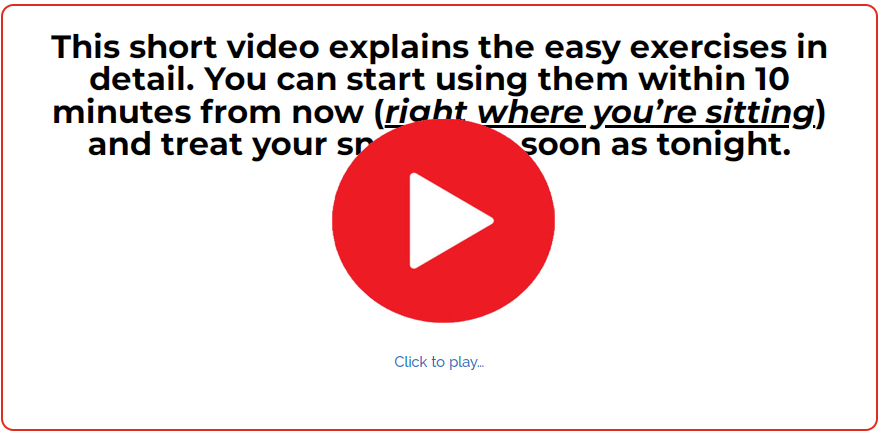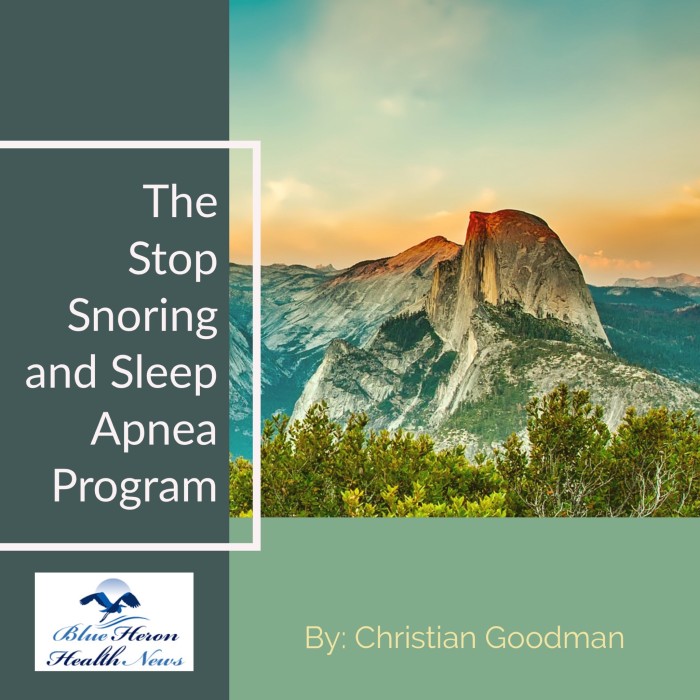This eBook from Blue Heron Health NewsBack in the spring of 2008, Christian Goodman put together a group of like-minded people – natural researchers who want to help humanity gain optimum health with the help of cures that nature has provided. He gathered people who already know much about natural medicine and setup blueheronhealthnews.com. Today, Blue Heron Health News provides a variety of remedies for different kinds of illnesses. All of their remedies are natural and safe, so they can be used by anyone regardless of their health condition. Countless articles and eBooks are available on their website from Christian himself and other natural health enthusiasts, such as Julissa Clay , Shelly Manning , Jodi Knapp and Scott Davis. The Stop Snoring And Sleep Apnea Program™ By Christian Goodman The Stop Snoring and Sleep Apnea Program is a well-researched program created to help stop snoring and sleep apnea so that you can have a good night sleep. The techniques that you will learn from this program works immediately. It will only take you 3-7 minutes to perform these simple exercises that the author has recommended but the results that you will get will help you have a good night sleep as soon as tonight. Within a week, snoring will be a thing of the past.
|
Early Research on Snoring
Early observations of snoring go back centuries, but scientific research became more systematic in the late 19th and early 20th centuries. The following are the major developments historically:
1. Historical and Ancient References
Snoring is mentioned in medical literature since ancient times. Ancient Greek and Roman doctors, including Hippocrates and Galen, wrote about sleep breathing disturbances.
Traditional Chinese and Ayurvedic medicine both recognized snoring as a sign of an imbalance in the body’s energy systems.
2. 19th Century: The First Medical Observations
In the 1830s, British physician Charles Bell wrote about obstructed breathing during sleep in some of his neurological patients.
The term “stertorous breathing” (a term describing loud, labored snoring) appeared in medical literature.
In 1877, German physician Wilhelm Heinrich Erb linked snoring with muscular weakness and nervous disease.
3. Early 20th Century: Snoring and Sleep Disorders
1909: Sir William Osler, one of the founders of modern medicine, identified snoring as a symptom of upper airway obstruction.
1920s-1930s: Physicians observed a link between snoring and daytime sleepiness, without knowing the mechanisms.
1934: American surgeon Samuel Flagg Bemis has described “obstructive snoring”, noting that collapse of the airway could lead to interruptions in breathing.
4. Mid-20th Century: The Discovery of Sleep Apnea
1956: Dr. C.S. Burwell used the phrase “Pickwickian syndrome” after he linked obesity, heavy snoring, and daytime drowsiness with a syndrome described in Charles Dickens’ book The Pickwick Papers.
1965: French scientist Henri Gastaut used polysomnography (a technique of sleep study) to demonstrate that snoring can be related to obstructive sleep apnea (OSA).
1970s: Scientists determined that snoring is caused by vibrations of the soft palate and pharyngeal walls and that excessive snoring can lead to oxygen desaturation and cardiovascular issues.
5. Modern Research and Treatments
Since the 1980s, research expanded to examine the biomechanics of snoring, genetics, as well as treatments like CPAP (Continuous Positive Airway Pressure) and surgery.
Today, snoring has been recognized as a major risk factor for sleep disorders and has been under intensive research for its link with heart disease, stroke, and metabolic disorders.
The initial work laid the foundation for what is known today about snoring and its potential health hazard. The field is still evolving, with constant research being conducted in sleep medicine and airway management.
The history of sleep apnea diagnosis is long, evolving from its early description as a medical curiosity to today’s precise and scientifically grounded practice. What follows is an overview of its development over the years:
1. Early Recognition (Pre-1900s)
Ancient References: Although sleep apnea as a diagnosis was not yet recognized, ancient writings, such as those of ancient Egypt and Greece, do mention disturbed sleep, snoring, and respiratory problems during sleep.
Snoring occasionally was also described as a sign of other medical problems, but it wasn’t until later that its connection with obstructive sleep apnea (OSA) began to be made.
2. Early Medical Recognition (1900s–1950s)
1918: The first documented case of sleep apnea appeared in medical literature. However, it was not understood as a disorder. Physicians noticed patients who had excessive daytime sleepiness but would often attribute it to other causes.
1950s: Physicians began to notice that some patients, especially those with excessive daytime sleepiness, also had abnormal breathing during sleep. However, there was still no distinct understanding of the mechanisms of sleep apnea.
3. Formal Identification (1960s–1970s)
1965: American otolaryngologist Dr. Charles F. Collins is often credited with the first detailed description of sleep apnea. He observed that some patients had recurrent episodes of airway obstruction during sleep, resulting in arousal and disrupted sleep.
1970s: “Sleep apnea” (Greek for “no breath”) was a term being used more and more. Clinicians and researchers were beginning to link the dots between sleep-disordered breathing and its impact on health, such as high blood pressure and heart disease.
4. Refinement of Diagnostic Tools (1980s)
Polysomnography (PSG): The era of sleep apnea diagnosis started with the introduction of polysomnography, which was a comprehensive examination of sleep through the monitoring of brain waves, heart rate, oxygen saturation, and other bodily functions during sleep. With this, it became feasible to diagnose obstructive sleep apnea (OSA) on the basis of disruption in breathing and desaturation of oxygen.
1981: Dr. William C. Dement and others made significant contributions to the understanding of sleep apnea’s impact on the cardiovascular system, and they used polysomnography to continue researching the disorder.
1980s: Sleep centers and sleep specialists became more prevalent, which contributed to more precise diagnoses and a greater understanding of sleep disorders, including sleep apnea.
5. Expansion of Awareness & Technology (1990s–2000s)
Continuous Positive Airway Pressure (CPAP): The introduction of CPAP therapy by Dr. Sydney S. Greenberg in the late 1980s revolutionized the treatment of sleep apnea. The therapy employs a machine to maintain open airways, which further supported the recognition of sleep apnea as a serious condition that must be treated. There was also increased research, publication, and clinical interest in sleep disorders during this period.
Home Sleep Apnea Testing (HSAT): The 2000s witnessed the introduction of home-based diagnostic devices, which allowed sleep apnea testing to be performed outside the clinic. While less comprehensive than polysomnography at first, the tests have achieved widespread application owing to their convenience and low cost.
6. Recent Advances (2010s–Present)
Advanced Polysomnography: Modern polysomnography has also evolved, with more parameters being added, such as video monitoring and more advanced data analysis.
Portable Diagnostic Equipment: More portable diagnostic equipment, like wearable technology, allows for home diagnosis with more ease. Devices can monitor vital signs and alert patients to signs of sleep apnea, allowing for earlier diagnosis and more awareness.
Artificial Intelligence (AI): AI and machine learning algorithms are being applied to analyze sleep data more efficiently, identifying patterns not apparent through traditional methods.
7. Future Directions
Genetic Research: Current research is investigating the role of genetics in sleep apnea, potentially leading to earlier diagnosis and more personalized treatments.
Home Sleep Studies: Ongoing development in the field of home sleep monitoring, assisted by smartwatches and other advanced sensors, should help to expand access to diagnosis and treatment.
Would you like more information about any of these significant developments or about the application of specific technologies in sleep apnea diagnosis?

The Stop Snoring And Sleep Apnea Program™ By Christian Goodman The Stop Snoring and Sleep Apnea Program is a well-researched program created to help stop snoring and sleep apnea so that you can have a good night sleep. The techniques that you will learn from this program works immediately. It will only take you 3-7 minutes to perform these simple exercises that the author has recommended but the results that you will get will help you have a good night sleep as soon as tonight. Within a week, snoring will be a thing of the past.
This eBook from Blue Heron Health NewsBack in the spring of 2008, Christian Goodman put together a group of like-minded people – natural researchers who want to help humanity gain optimum health with the help of cures that nature has provided. He gathered people who already know much about natural medicine and setup blueheronhealthnews.com. Today, Blue Heron Health News provides a variety of remedies for different kinds of illnesses. All of their remedies are natural and safe, so they can be used by anyone regardless of their health condition. Countless articles and eBooks are available on their website from Christian himself and other natural health enthusiasts, such as Julissa Clay , Shelly Manning , Jodi Knapp and Scott Davis. |
